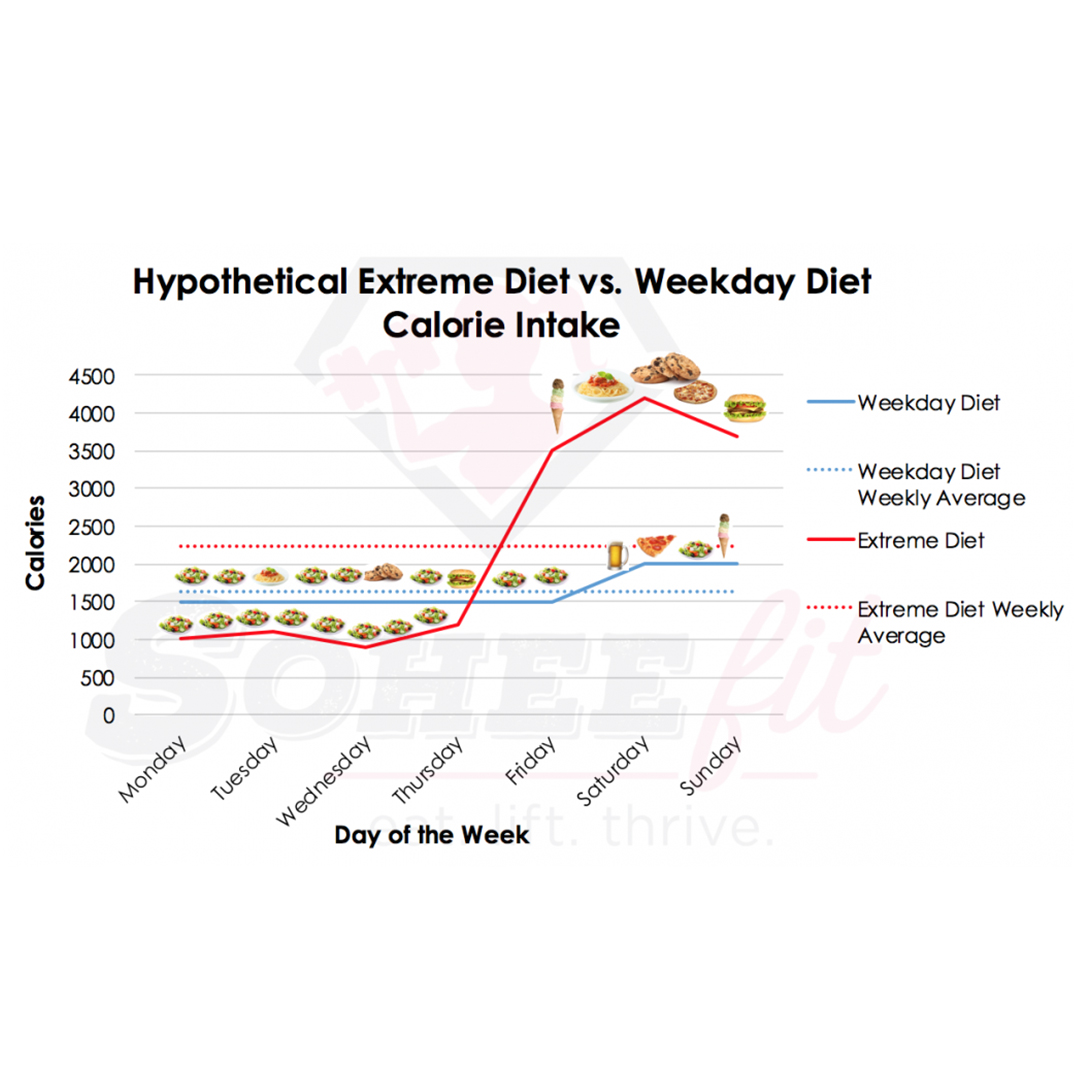The Weekday Diet

A few years ago, I started noticing a trend with people who would come to me for help with their diets. When asked what their biggest struggle with nutrition was, an alarming majority would confess that they usually had no problem being strict with their eating during the week, but all hell would break loose over the weekends. Usually, this would be due to having a busy routine from Monday to Friday with little time to unwind, and then being hit with a slew of social events and downtime on Saturday and Sunday.
In light of this, I’ve been switching more and more of my clients over to a different kind of nutrition structure.
Enter the Weekday Diet.
During the week, I provide more structure to individuals, with a set number of grams of proteins, carbs, and fats that they are to hit. The whole point is to take advantage of the very fact that they’re busy and not focused so much on food to really drive home that energy deficit, so their Calories are typically in the lower range.
However, on the weekends, I let them unwind a little – they can relax their intake and kick back. A crucial point here, however, is not to let the weekend spiral out of control. It’s still somewhat structured, but they do have a limit. I’ll use this time to either set them on the high end of their dieting Calories or bring them back up to maintenance Calories.
To do this, I simply set a caloric ceiling and a protein minimum. That’s it. It looks something like:
2,100 total Calories
120g protein minimum
Any combination of carbs and fats
In other words, they are to hit a 120g protein minimum but specific carb and fat numbers are entirely up to them so long as they hit 2,100 total Calories for the day. (Remember that 1g protein = 4 Calories, 1g carb = 4 Calories, and 1g fat = 9 Calories.) The protein and Calorie recommendations will vary from one person to the next, of course.
Do you see what I did here?
I took into account the individual’s nutrition struggles and made it work for them. I used to prescribe an isocaloric diet to everyone to came to me, meaning that they consumed the same number of calories every single day. But if their weekly average intake puts them in a deficit, why can’t we take a few hundred calories from the week and pad them onto the weekend?
Here’s a visual representation of what it could look like:
The red solid line represents the hypothetical daily caloric intake of someone on an extreme diet. I say hypothetical here, but the truth of the matter is I’ve seen very similar variations of this manifested in countless individuals (particularly women, but men as well). There are even some folks to take it even more extreme, with sub-1,000 Calories during the week and then binge eating with well over 5,000 Calories over the weekend.
The blue solid line is the hypothetical daily Calorie intake of someone on the Weekday Diet. Notice how the Calories during the week are higher than that of the extreme diet, and on the weekends, the Calories are lower that of the extreme diet (by a good bit).
Why is this important? Because as you can see from the dotted lines that represent the weekly average Calories, the Weekday Diet ends up consuming far fewer Calories.
Alternatively, if you’re someone who likes eating the same way over the weekend as you do during the week (such as myself), you might do well with a more moderate approach.
Again, the red solid line represents the Caloric intake on an extreme diet. The yellow solid line represents the moderate diet. Since the daily Calories are the same, the weekly average is going to be at that same number (hence why you can’t see the yellow dotted line – the yellow solid line is directly on top of it), and as this graph shows, the weekly average of the extreme diet is still several hundred Calories higher.
The point is that you want to structure your Calories (and carbs and fats) throughout the week such that you can feel good and keep dietary adherence high. That’s going to look different for everyone.
Here are some important reminders about dieting:
- The more restrictive you are with your diet, the more likely you are to engage in binge eating and have higher bodyweight. This has been shown time and time and time and time and time again. This sounds completely counterintuitive to people at first, but what you have to take into consideration is that no matter what kind of diet you’re on, you need to actually be able to adhere to it.
- Speaking of, dietary adherence is the most important determinant of weight loss success. I love this study in particular because it so eloquently demonstrates that there’s no magic formula out there that’s going to yield lasting results except consistency, consistency, consistency.
- The typical dieting mentality – that of deprivation and suffering – is enough to trigger severe incidences of overeating. The colloquial term for this is Last Chance Syndrome, as in, “This is the last chance I get to eat this [forbidden food] until next week, so I’d better eat as much as of it as I can!” Urbszat, Herman, and Polivy found this in their 2002 study in which restrained eaters (those who had been told to diet for several weeks) consumed significantly more of a ‘forbidden food’ during a taste test than unrestrained eating (non-dieters). (Sidenote: Herman and Polivy are two researchers who have been very involved in the research on dieting, so familiarize yourself with those names.)
- “Just try harder” or “be more strict” is rarely ever the answer when it comes to achieving diet success. Wendy Wood stands out in the field of habits, and this study of hers in particular shows that healthy dietary habits (rather than white-knuckling behaviors) are key in meeting self-regulatory goals. In other words, it’s not that you need more self-control per se, but better dietary habits overall.
- A weekend of irresponsible eating can absolutely erase a whole week’s worth of hard work. I’m sure you or someone you know has been through this before. It’s a slippery slope to an endlessly frustrating cycle of restrict, binge, restrict binge. What’s worse, you don’t make any forward progress – and in fact, you may even find yourself regressing. This is why it’s so crucial to keep everything in check.
The Weekday Diet came about because it really only feels like you’re dieting during the week, when in actuality you’re still making successful fat loss progress because your weekly average puts you in a deficit. The whole premise of this method is that you push a little harder during the week so you can relax a bit more on the weekend. Contrast this with going all out and then crashing and burning.
Obviously, the two higher Calorie days can fall on any two days throughout the week. I recommend that you choose the days when you know you’re going to be the most social or when you know you could really use that mental break. That might be Wednesday and Saturday, or Friday and Saturday… it’s entirely up to you. (And to take it even further, yes, you could make your Weekday Diet four days long and give yourself a three-day weekend with higher Calories. That would either mean, however, that your weekday Calories would have to be a smidge lower than what they would otherwise be so that your weekly average works out to keep you in a deficit, or that you’ll see slower fat loss progress. Your choice!)
I’ve yet to see another coach implement this specific strategy with the sole purpose of providing psychological relief and thereby increasing enjoyment of the program and overall dietary adherence – hence this post.
This is about making your nutrition work for your life and not the other way around.
If you’re a coach who has online clients, I encourage you to try out this method with some of your clients for whom you think this might be a good fit for. If you’re a fitness buff yourself, perhaps you’ll want to try it out on yourself. This has worked beautifully with many of my clients and I suspect I’ll be converting more and more of them over in the months and years to come.
References
Alhassan, S., Kim, S., Bersamin, A., King, A. C., & Gardner, C. D. (2008). Dietary adherence and weight loss success among overweight women: results from the A TO Z weight loss study. International Journal of Obesity, 32(6), 985-991.
Gallant, A. R., Tremblay, A., Pérusse, L., Bouchard, C., Després, J. P., & Drapeau, V. (2010). The Three-Factor Eating Questionnaire and BMI in adolescents: results from the Quebec family study. British Journal of Nutrition, 104(07), 1074-1079.
Lin, P. Y., Wood, W., & Monterosso, J. (2015). Healthy eating habits protect against temptations. Appetite, 30, 1e9.
Smith, C. F., Williamson, D. A., Bray, G. A., & Ryan, D. H. (1999). Flexible vs. Rigid dieting strategies: relationship with adverse behavioral outcomes. Appetite, 32(3), 295-305.
Stewart, T. M., Williamson, D. A., & White, M. A. (2002). Rigid vs. flexible dieting: association with eating disorder symptoms in nonobese women. Appetite, 38(1), 39-44.
Timko, C. A., & Perone, J. (2005). Rigid and flexible control of eating behavior in a college population. Eating Behaviors, 6(2), 119-125.
Urbszat, D., Herman, C. P., & Polivy, J. (2002). Eat, drink, and be merry, for tomorrow we diet: Effects of anticipated deprivation on food intake in restrained and unrestrained eaters. Journal of abnormal psychology, 111(2), 396.
Westenhoefer, J., Stunkard, A. J., & Pudel, V. (1999). Validation of the flexible and rigid control dimensions of dietary restraint. International Journal of Eating Disorders, 26(1), 53-64.




